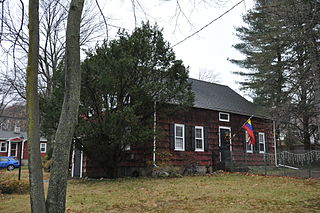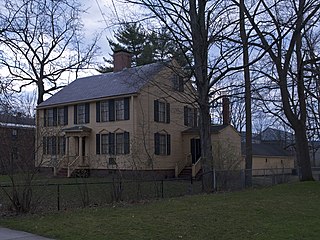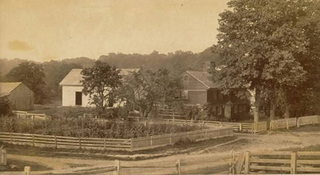
The Russell Company Upper Mill is an historic structure in Middletown, Connecticut, at the junction of Russell Street and East Main Street in South Farms, at the end of East Main Street's commercial and industrial development areas. Built in 1836, it is listed on the National Register of Historic Places. There is a small pond to the south. Small businesses border the street to the north, followed by the buildings of Russell Manufacturing Company, the area's most dominant feature. Russell Street crosses Sumner Brook nearby and ascends to a large residential district to the west. The mill is currently a condo-apartment complex.

The James Semple House is a historic house on Francis Street in Colonial Williamsburg, Williamsburg, Virginia. Built about 1770, it is a prominent early example of Classical Revival residential architecture, whose design has been attributed to Thomas Jefferson. It was declared a National Historic Landmark in 1970.

The Samuel Bancroft House is a historic house in Reading, Massachusetts. With an estimated construction date of 1748, it is one of the town's older surviving houses, and one of a small number from the late colonial period. It was listed on the National Register of Historic Places in 1984.

The Eells-Stow House is operated as a historic house museum at 34 High Street in Milford, Connecticut. Built as a private residence and with a construction history dating to c. 1700, it is believed to be Milford's oldest surviving building. It has a complex history of later additions and alterations. It was listed on the National Register of Historic Places in 1977. It is now owned by the Milford Historical Society.

The Acadian House is a historic house on Union Street in Guilford, Connecticut. Built about 1670, it is one of Connecticut's oldest surviving houses, notable for its occupation by refugee Acadians following their 1755 deportation from Nova Scotia. The house was listed on the National Register of Historic Places in 1975.

The Samuel Ferris House is a historic house at 1 Cary Street in Greenwich, Connecticut. Built around 1760 and enlarged around 1800, it is a well-preserved example of a Colonial period Cape, a rare survivor of the form to still stand facing the Boston Post Road in the town. It is also locally significant for its connections to the Ferris family, early settlers of the area. The house was listed on the U.S. National Register of Historic Places in 1989.

The Wyman Tavern is a historic house, former tavern, and now a local history museum, at 339 Main Street in Keene, New Hampshire. Built in 1762 by Isaac Wyman, it also served as the muster ground for militia at the outbreak of the American Revolutionary War. In 1968 the property was acquired by a local non-profit, which leases it to the Cheshire County Historical Society for use as a museum. The building was listed on the National Register of Historic Places in 1972.

The General Porter House is a historic house at 32-34 Livermore Street in Portsmouth, New Hampshire. Built about 1751, it is a well-preserved example of a Portsmouth gambrel-roofed double house, and has been home to a number of prominent individuals. Now housing residential condominiums, it was listed on the National Register of Historic Places in 1985.

The Timothy Hart House is a historic house at 521 Flanders Road in Southington, Connecticut. Built about 1810, it is a well-preserved local example of vernacular early 19th-century Federal period architecture. It was listed on the National Register of Historic Places in 1989.

The Jotham Woodruff House is a historic house at 11 Alyssa Court in Southington, Connecticut. Probably built about 1790, it is a good local example of late Georgian architecture with later Greek Revival alterations. It was listed on the National Register of Historic Places in 1989.

The Gridley-Parson-Staples House is a historic house museum at 1554 Farmington Avenue in Farmington, Connecticut. Probably built about 1760, it is the oldest surviving house in northwestern Farmington, and a fine example of 18th century Georgian architecture. It is now home to the Farmington Historical Society, and was listed on the National Register of Historic Places in 1981.

The John Hollister House is a historic house at 14 Tryon Street in the South Glastonbury village of Glastonbury, Connecticut. Built about 1675, it is the town's oldest surviving colonial structure, built by one of its early settlers. It was listed on the National Register of Historic Places in 1972.

The Elisha Seymour Jr. House is a historic house at 410-412 Park Road in West Hartford, Connecticut. Built about 1770, it is one of the town's few surviving pre-independence brick buildings. it was listed on the National Register of Historic Places in 1986.

The Moses Andrews House is a historic house museum at 424 West Main Street in Meriden, Connecticut. Built about 1760, it is one of a small number of surviving 18th-century houses in the city. It has been operated by the local historical society as a museum property since about 1940. It was listed on the National Register of Historic Places in 1978.

The Cheshire Historic District encompasses the historic town center of Cheshire, Connecticut. Centered on the junction of Main Street and Academy Road, the district's architecture is reflective of the town's development over two centuries, and includes many of its civic buildings. It was listed on the National Register of Historic Places in 1986.

The Reuben Curtiss House is a historic house at 1770 Bucks Hill Road in Southbury, Connecticut. With a construction and alteration history dating from the late 18th to 20th centuries, the house is one of Southbury's finest examples of residential Greek Revival architecture. It was listed on the National Register of Historic Places in 1993.

The Edward Frisbie House is a historic house at 699 East Main Street in Branford, Connecticut. Probably built about 1750, it is a fine local example of Georgian residential architecture, historically attributed to one of the area's early settlers. It was listed on the National Register of Historic Places in 1988.

The Franklin Johnson House is a historic house at 153 South Main Street in Wallingford, Connecticut. Built in 1866, it is a distinctive local example of Italianate architecture. It was listed on the National Register of Historic Places in 1998. It is now home to the American Silver Museum, which is generally open by appointment or on special occasions.

The Theophilus Jones House is a historic house at 40 Jones Road in Wallingford, Connecticut. Built about 1740, it is one of the town's oldest surviving buildings, also notable for its restoration in the 1940s by Charles F. Montgomery. It was listed on the National Register of Historic Places in 1992.

The Sanford-Humphreys House is a historic house at 61-63 West Street in Seymour, Connecticut. The house has a construction history dating to the 1790s, and is associated with two prominent figures in Seymour's history: Samuel Sanford, the area's first doctor, and General David Humphreys, a soldier, diplomat, and businessman who developed the first textile mills in the area. The house was listed on the National Register of Historic Places in 1982.






















